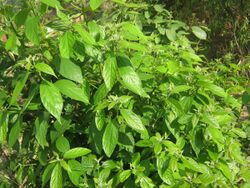Biology:Cinnamomum glaucescens
| Cinnamomum glaucescens | |
|---|---|

| |
| Cinnamomum glaucescens plant in Panchkhal valley | |
| Scientific classification | |
| Kingdom: | Plantae |
| Clade: | Tracheophytes |
| Clade: | Angiosperms |
| Clade: | Magnoliids |
| Order: | Laurales |
| Family: | Lauraceae |
| Genus: | Cinnamomum |
| Species: | C. glaucescens
|
| Binomial name | |
| Cinnamomum glaucescens (Nees) Hand.-Mazz.
| |
| Synonyms | |
| |
Cinnamomum glaucescens (Nepali:सुगन्धकोकिला, Sugandhakokila) is an evergreen tree native to Bhutan, India (Sikkim, Manipur and the Khasi Hills), and Nepal. The pericarp of the fruits can be distilled for an essential oil, sugandha kokila oil, which is used in perfumery and traditional medicine.[2]
This species is diploid and can grow to an altitude of 1,300 m (4,300 ft).[3] Cinnamomum glaucescens is recognized as an aromatic plant, meaning it has an elevated level of essential oil.[4]
Cultivation
Cinnamomum glaucescens has been successfully cultivated,[5] and promotes species conservation.[6] A ranking scale was established,[7] assessing mode of domestication, cultivation and social beliefs from farmer or forest users perspective, to rank the suitability of MAPs for farming. With the highest ranking being five, and lowest zero, sugandha kokila ranked four out of five.[7] This demonstrate that Cinnamomum glaucescens is not only physiologically appropriate for cultivation but also has a high chance to be adopted by farmers, when compared with other MAPs. Furthermore, the GEF Small Grants Programme ran a successful project mobilizing two indigenous Nepalese communities, promoting the knowledge and tools to cultivate sugandha kokila.[5] The project amended the two involved communities’ local forestry operation plan to include the conservation of Cinnamomum glaucescens.[5] The two communities involved planted Cinnamomum glaucescens 13ha of community forests, in addition to 6ha planted on private land.[5] Increasing the market demand of sugandha kokila oil will not only benefit the farmers and producers in Nepal but also encourage the conservation of Cinnamomum glaucescens. As the market grows, the plant will increase in value, encouraging more cultivation of the plant and therefore increase conservation efforts. Also, three women-run forest nurseries established, responsible for growing 30,000 seedlings of sugandha kokila, sapindus, cinnamon, zanthoxylum, lemon and asparagus.[5] Creating women run nurseries empowered women to learn new skills and play an important role in the cultivation of sugandha kokila and other products. Additionally, 86 households were supported in developing suitable infrastructure for the processing of sugandha kokila.[5] This project is an example of how the cultivation of sugandha kokila using a community approach can empower women and conserve this endemic plant.
References
- ↑ SUGANDHA KOKILA OIL. Everest Herbs processing Pvt. Ltd.. http://www.everestherbs.com.np/products/oil/sugandhakokila.htm. Retrieved 2012-05-08.
- ↑ "Cinnamomum glaucescens". ForestryNepal. http://www.forestrynepal.org/resources/trees/cinnamomum-glaucescens. Retrieved 28 March 2013.
- ↑ Ravindran, P.N; Nirmal-Babu, K.; Shylaja, M. (2003). Cinnamon and cassia: the genus Cinnamomum. CRC press. pp. 337. ISBN 9780203590874. https://books.google.com/books?id=KZa8aPxR_-wC. Retrieved 23 November 2015.
- ↑ Gurung, K. "Study on Quality Issues of Medicinal and Aromatic Plants (MAPs) Sector in Nepal". http://www.jadibutinepal.com/attachments/article/86/MAPs%20QI%20report.pdf. Retrieved 23 November 2015.
- ↑ 5.0 5.1 5.2 5.3 5.4 5.5 "Promotion of Sugandha Kokila (Cinnamomum glaucescens) and Improvement in Marketing System for Livelihood Enhancement Project". 2012. https://www.sgp.undp.org/index.php?option=com_sgpprojects&view=projectdetail&id=19451&Itemid=205. Retrieved 23 November 2015.
- ↑ Maraseni, T.N. (2008). "Selection of non-timber forest species for community and private plantations in the high and low altitude areas of Makawanpur District, Nepal". Small-Scale Forestry 7 (2): 151–161. doi:10.1007/s11842-008-9047-1. http://eprints.usq.edu.au/4106/2/Maraseni_Small-Scale_Forestry_v7n2_Author%27s_version.pdf.
- ↑ 7.0 7.1 "A Report on Compilation and Prioritization of Ten Important NTFPs of Nepal for Commercial Promotion through Private Sector Investment". 2006. http://www.aec-fncci.org/wp-content/uploads/2015/01/Priotization-of-10-important-NTFps-AEC.pdf. Retrieved 23 November 2015.
Wikidata ☰ Q5121025 entry
 |

